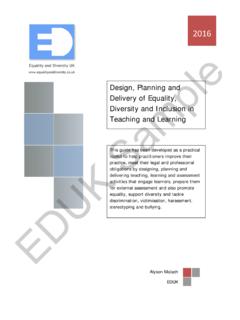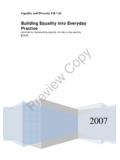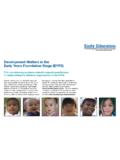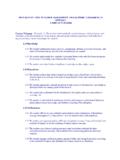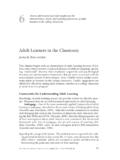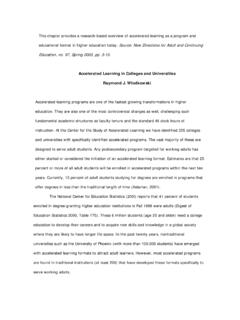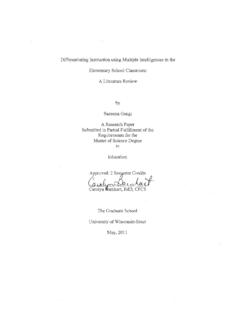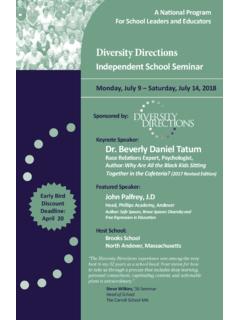Transcription of Completed Formal Classroom Observation Form - …
1 Completed Formal Classroom Observation form (Once participants have filled in and discussed the blank Formal Classroom Observation form , facilitators should hand out copies of this Completed form ). August 2012. Formal Classroom Observation form Directions: This form is to be used for probationary teachers and teachers with continuing contract status. Observers should use the form to provide feedback to teachers about the Observation . Teacher A October 11, 2012 10:45-11:30. Teacher's Name Date Observed Time Principal A The teacher is: Probationary Continuing Contract Observer's Name 1. Professional Knowledge The teacher demonstrates an understanding of the curriculum, subject content, and the developmental needs of students by providing relevant learning experiences.
2 Effectively addresses appropriate curriculum Demonstrates skills relevant to the subject standards. area(s) taught. Integrates key content elements and facilitates Bases instruction on goals that reflect high students' use of higher level thinking skills in expectations and an understanding of the instruction. subject. Demonstrates ability to link present content with past Demonstrates an understanding of the and future learning experiences, other subject areas, intellectual, social, emotional, and physical and real-world experiences and applications. development of the age group. Demonstrates an accurate knowledge of the subject Communicates clearly and checks for area(s) taught.
3 Understanding. Comments: Addresses appropriate curriculum standards and integrates key content elements - lesson objectives aligned to third grade mathematics standards - ( Observation and Documentation). Facilitates students' use of higher-level thinking skills in instruction - mathematics task using manipulatives to analyze arrays necessitates use of creative and higher-level thinking skills; asked both lower level and higher level questions during discussion - ( Observation ). Links present content with past and future learning experiences, other subject areas, and real-world experiences and applications - connected to prior lessons on arrays and art class work on columns - ( Observation ).
4 Content knowledge is appropriate for the lesson (Observations and Documentation). Exhibits pedagogical skills relevant to the subject area(s) taught and best practice based on current research - abstract to concrete with manipulative use; graphic organizers; working in pairs to support learning and academic conversations some students needed more assistance during guided practice - more scaffolding needed - ( Observation ). Bases instruction on goals that reflect high expectations for all students and a clear understanding of the curriculum - guided practice was challenging to all students [too challenging for some]; higher level students given additional numbers to consider - ( Observation ).
5 2. Instructional Planning The teacher plans using the Virginia Standards of learning , the school's curriculum, effective strategies, resources, and data to meet the needs of all students. Uses student learning data to guide planning. Aligns lesson objectives to the school's curriculum Plans time realistically for pacing, content mastery, and student learning needs. and transitions. Develops appropriate long- and short-range plans Plans for differentiated instruction. and adapts plans when needed. Comments: Arrays lesson is aligned to lesson objectives and curriculum (Documentation). A variety of resources are used for the mathematics lesson to include a storybook and SMARTB oard (Documentation).
6 Important components of lesson built in - direct instruction, modeling, student practice, student sharing, metacognition - (Documentation). Integrates literacy into math instruction - (Documentation). Lesson is coherent, sequenced, and aligned to curriculum standards (Documentation). Lesson requires deep, critical, and creative thinking and understanding of concepts (Documentation). Instructional strategies and practices are relevant to content area (Documentation). 3. Instructional Delivery The teacher effectively engages students in learning by using a variety of instructional strategies in order to meet individual learning needs. Engages and maintains students in active learning .
7 Uses a variety of effective instructional strategies Builds upon students' existing knowledge and and resources. skills. Uses instructional technology to enhance student Differentiates instruction to meet the students' learning . needs. Communicates clearly and checks for Reinforces learning goals consistently throughout understanding. lessons. Comments: Engages and interests students during the whole group portion of the lesson. When students work in pairs, engagement is inconsistent. Higher level students are engaged, lower level students having difficulties are distracted by the tasking - ( Observation ). Builds on prior knowledge about columns and rows, but many children are confused - a graphic depicting this would have been helpful.
8 Perhaps more practice differentiating columns and rows would have benefitted students prior to the lesson. More time practicing together with some students was needed - ( Observation ). Uses a variety of instructional strategies to promote learning - manipulatives, direct instruction, guided practice, discussion, graphic organizers, student pairs. However, many of the confused students were paired together. Perhaps a multi-ability level pairing would have been better - ( Observation ). Reinforces learning goals consistently throughout the lesson - introduces lesson objective and continues to remind, restate, and reinforce what they are doing. However, it took a long time for students to understand.
9 Even at the conclusion of the lesson there were still students who did not have a clear understanding - ( Observation ). Communicates and presents material clearly, and checks for understanding - clear communication and regular checks for understanding. However, when so many students are having difficulties, it would make sense to regroup and work with those students together as it was clear that many were having difficulties - ( Observation ). 4. Assessment of and for Student learning The teacher systematically gathers, analyzes, and uses all relevant data to measure student academic progress, guide instructional content and delivery methods, and provide timely feedback to both students and parents throughout the school year.
10 Uses pre-assessment data to develop expectations Uses assessment tools for both formative and for students, to differentiate instruction, and to summative purposes and uses grading practices that document learning . report final mastery in relationship to content goals Involves students in setting learning goals and and objectives. monitoring their own progress. Uses assessment tools for both formative and Uses a variety of assessment strategies and summative purposes to inform, guide, and adjust instruments that are valid and appropriate for the students' learning . content and for the student population. Gives constructive and frequent feedback to Aligns student assessment with established students on their learning .










